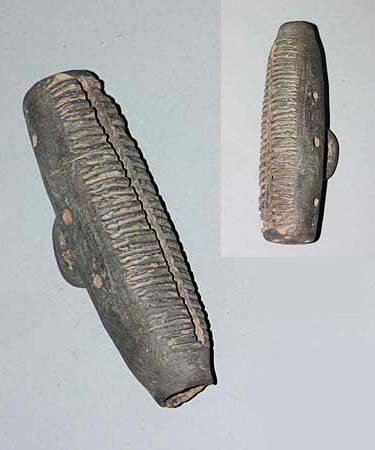
Owner: HWMC
Catalog#: ME-IDST-02-14
Provenance: Jay Gluck Collection
Iran ‘Rasp’ (Amlash Culture)
Iran
Iranian
Clay
1st Millennium, B.C.E.
Length: 5.75 in
Idiophones – Struck Idiophones – Scraped
The term Amlash culture refers to an assortment of historic materials and periods in the geographical region of Gilan (province in Iran) and west of Mazandaran, central northern Iran (also called Persia, and officially the Islamic Republic of Iran).
This Amlash (Amlaš ) pottery rasp shows intricate detail with two serrated surfaces divided by an elongated opening, three sound holes on each side and a fashioned handle in the back. It is a type of idiophone whereby the serrated surface is rasped (scraped) with a stick to produce a rattling sound. While representations of animal figures are abundant in Amlash pottery this rasp appears to be missing a finial as one end does not have the refined finish as the opposite end as seen in this picture. Rasps are often associated with magical power and ritual and are geographically ubiquitous.
This Amlash pottery rasp, 1st millennium B.C.E. comes from the Jay Gluck Collection. Provenance: Collection of the archaeologist Jay Gluck (1927-2000) and his wife Sumi Hiramoto Gluck. The Gluck collection, consisting of several thousand objects, was one of the largest private collections of Persian art in the world. It contained some of the oldest Persian antiquities in existence. Many pieces from the collection have been exhibited for a long time in Persia House, Kobe, Japan and later in the Nara Orient Kan Museum, Japan. Parts of the collection were later moved to the Miho Museum, Japan, and other museums.
Jay Gluck was an American archaeologist and specialist for the history of Persian art. He graduated from the University of California, Berkeley in 1949 in Archaeology and Middle Eastern Studies. In 1966 he became director of the Asia Institute of the Pahlavi University in Iran. He is also well known for republishing the work of Arthur Upham Pope, A Survey of Persian Art.
Resource: Amlash culture – Wikipedia
